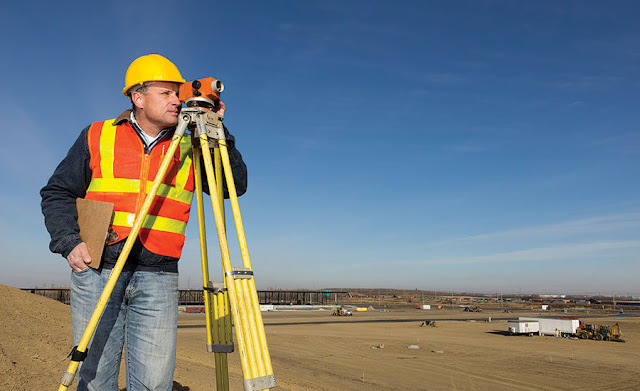Surveying- Definition and Classification
What is Surveying
Definition
Surveying is the art of determining the relative position of the different objects on the surface of the earth by measuring the horizontal distance between them, and by preparing a map to any suitable scale. The measurement is taken in the horizontal plane.
Leveling is the art of determining the relative vertical distance of different points on the surface of the earth. Therefore, in leveling, the measurements are taken only in the vertical plane.
Object Of Surveying
The aim of surveying is to prepare a map to show the relative positions of the objects on the surface of the earth. The map is drawn to some suitable scale. It shows the natural features of a country, such as towns, villages, roads, railways, rivers, etc. Maps may also include details of different engineering works, such as roads, railways, irrigation canals, etc.
i. To prepare a topographical map.
ii. To prepare an engineering map.
iii. To prepare a military map.
iv. To prepare a contour map.
v. To prepare a cadastral map.
vi. To prepare a geological map.
To prepare a map for rural areas, the developed town planning can be made with ideal residential, commercial, and industrial activities.
 |
| Surveying |
Classification
Surveying is classified into two types
1) Primary Surveying.
2) Secondary Surveying.
1) Primary Surveying
Plane Surveying
In this survey, the curvature of the earth is not taken into consideration. This surface is obviously curved. But in plane surveying, the curvature of the earth is not taken into consideration. This is because plane surveying is carried out over a small area. So, the surface of the earth is considered a plane. In such surveying, a line joining any two points is considered straight. The triangle formed by any three points is considered a plane triangle and the angles of the triangle are assumed to be plane angles. Plane surveying is conducted by state agencies like the Irrigation Department, Railway Department, etc. Department, Railway Department, etc.
Plane surveying is done on an area of fewer than 250 KM2.
Geodetic surveying
In geodetic surveying, the curvature of the earth is taken into consideration. It is extended over a large area. The line joining any two points is considered a curved line. The triangle formed by any three points is considered spherical and the angles of the triangle are assumed to be spherical angles. Geodetic surveying is conducted by the survey of India department and is carried out over an area exceeding 250 KM2.
2) Secondary Surveying
a) Based on instruments
i. Chain surveying.
ii. Campus surveying.
iii. Plane table surveying.
iv. Theodolite surveying.
v. Tachometric surveying.
vi. Photographic surveying.
b) Base on method
i. Triangulation surveying.
ii. Traverse surveying.
c) Based on object
i. Mine surveying.
ii. Geological surveying.
iii. Military surveying.
iv. Archaeological surveying.
d) Based on the nature of the field
i. Land surveying.
ii. Marine surveying.
iii. Astronomical surveying.
Principle Of Surveying
General principles of surveying are
(i) To work from the whole to the part
The whole area is first enclosed by main stations and main survey lines. The area is then divided into many parts of forming wall conditioned triangle in which no angle is less than 300 and greater than 1200. The main survey lines are measured very accurately with a standard chain. Then the sides of the triangles are measured. The purpose of this process of working is to prevent the accumulation of errors. During this procedure, if there is an error in the measurement of any side of a triangle then it will not affect the whole work. The error can always be detected and eliminated.
(ii) To locate a new station by at least two measurements from fixed reference points
The new station should always be fixed by at least two measurements from fixed reference points. Linear measurements are measured by chain or taps and angular measurements are taken by a prismatic compass or theodolite. Linear measurements refer to horizontal distances measured by a chain or tape. Angular measurements refer to the magnetic bearing or horizontal angle taken by a prismatic compass or theodolite.
In chain surveying, the positions of main stations and directions of main survey lines are fixed by tie lines and check lines.
Uses Of Surveying
Surveying may be used for the following various applications
(i) To prepare a topographical map which shows the hills, valleys, rivers, villages, towns, forests, etc.
(ii) To prepare an engineering map that shows the details of engineering works such as roads, railways, reservoirs, irrigation canals, etc.
(iii) To prepare a cadastral map showing the boundaries of fields, houses, and other properties.
(iv) To prepare a military map showing the road and railway communications with different parts of a country.
(v) To prepare a contour map to determine a reservoir's capacity and find the best possible routes for roads, railways, etc.
(vi) To prepare a geological map showing areas including underground resources.
(vii) To prepare a map for rural areas, the developed town planning can be made with the ideal location for residential, commercial, and industrial activities.
Accessories For Linear Measurements
1. Ranging Rods
Rods that are used for ranging a line are known as ranging rods. Such rods are made of seasoned timber or seasoned bamboo. Sometimes GI pipes of 25 mm diameter are also used as ranging rods. They are generally circular in section, of 25 mm diameter and 2 m length. Sometimes wooden ranging rods are square in section. The rod is divided into equal parts of 20 cm each and the divisions are painted black and white or red and white alternately so that the rod is visible from a long distance. The lower end of the rod is pointed or provided with an iron shoe.
 |
| Surveying |
2. Chains
A chain is prepared with 100 or 150 pieces of galvanized mild steel wire of 4 mm diameter. The ends of the pieces are bent to form loops. Then the pieces are connected together with the help of three oval rings, which make the chain flexible. Two brass handles are provided at the two ends of the chain. Tallies are provided at every 10 or 25 links for the facility of counting. ‘One link’ means the distance between the centers of adjacent middle rings.
The following are the different types of chains:
(a) Metric chain.
(b) Steel band.
(c) Engineers chain.
(d) Gunter chain.
(e) Revenue chain.
(a) Metric chain
Metric chains are available in lengths of 20 m and 30 m. The 20 m chain is divided into 100 links, each of o.2 m. Tallies are provided at every 10 links(2m). This chain is suitable for measuring distances along fairly level ground.
(b) Steel Band
It consists of a ribbon of steel of 16 mm width and of 20 or 30 m lengths. It has a brass handle at each end. It is graduated in meters, decimetres, and centimeters on one side and has 0.2 m links on the other. The steel band is used in projects where more accuracy is required.
(c) Engineers Chain
The engineer's chain is 100 ft long and is divided into 100 links. So, each link is 1 ft. Tallies are provided at every 10 links(10 ft), the central tally being round. Such chains were previously used for all engineering works.
(d) Gunter Chain
It is 66 ft long and divided into 100 links. So, each link is 0.66 ft. It was previously used for measuring distances in miles and furlongs.
(e) Revenue Chain
The revenue chain is 33 ft long and divided into 16 links. It is mainly used in cadastral surveys.
 |
| Surveying |
Measuring Tapes
The following are the different types of tapes:
(a) Cloth or linen tape.
(b) Metallic tape.
(c) Steel tape.
(d) Invar tape.
(a) Cloth or linen tape
Such a tape is made of closely woven linen and is varnished to resist moisture. It is 15 mm wide and available in lengths of 10 and 15 m. This tape is generally used for measuring offsets and for ordinary works.
(b) Metallic Tape
When linen tape is reinforced with brass or copper wires to make it durable, it is called metallic tape. This tape is available in lengths of 15, 20, and 30m. It is wound on a leather case with a brass handle at the end. It is commonly used for all survey works.
(c) Steel tape
The steel tape is made of steel ribbon of width varying from 6 to 16mm. The commonly available lengths are 10, 15, 20, 30, and 50m. It is graduated in meter, decimetre, and centimeter. It is not used in the field, but chiefly for standardizing chains and for measurements in constructional works.
(d) Invar tape
Invar tape is made of an alloy of steel(64%) and nickel(36%). its thermal coefficient is very low. Therefore, it is not affected by changes in temperature. It is made in the form of a ribbon of 6 mm width and is available in lengths of 30, 50, and 100m. It is used at places where maximum precision is required. It is generally used in the triangulation survey conducted by the survey of India department.
 |
| Surveying |
Ranging
The process of establishing intermediate points on a straight line between two endpoints is known as range. Ranging must be done before a survey is chained. Ranging may be done by direct observation by the naked eye or by line ranger or by theodolite. Generally, ranging is done by the naked eye with the help of three ranging rods.
Ranging may be of two kinds:
1. Direct ranging.
2. Indirect or reciprocal ranging.
1. Direct Ranging
When intermediate ranging rods are fixed on a straight-line direct observation from end stations, the process is known as direct ranging. Direct ranging is possible when the end stations are inter-visible. The following procedure is adopted for direct ranging.
2. Indirect Ranging
When the end station is not inter-visible due to there being high ground between them, intermediate-ranging rods are fixed on the line indirectly. This method is known, as indirect ranging or reciprocal ranging. The following procedure is adopted for indirect ranging.







No comments
Thank You For Your Comment.